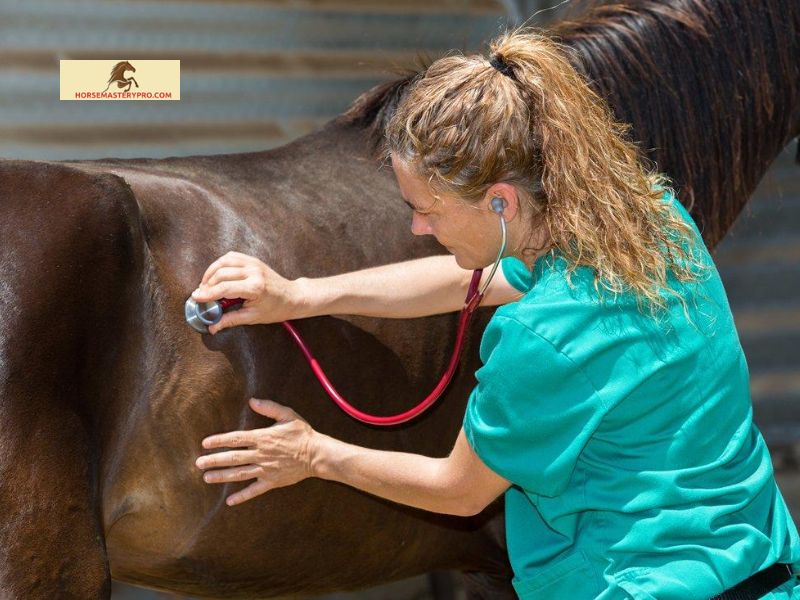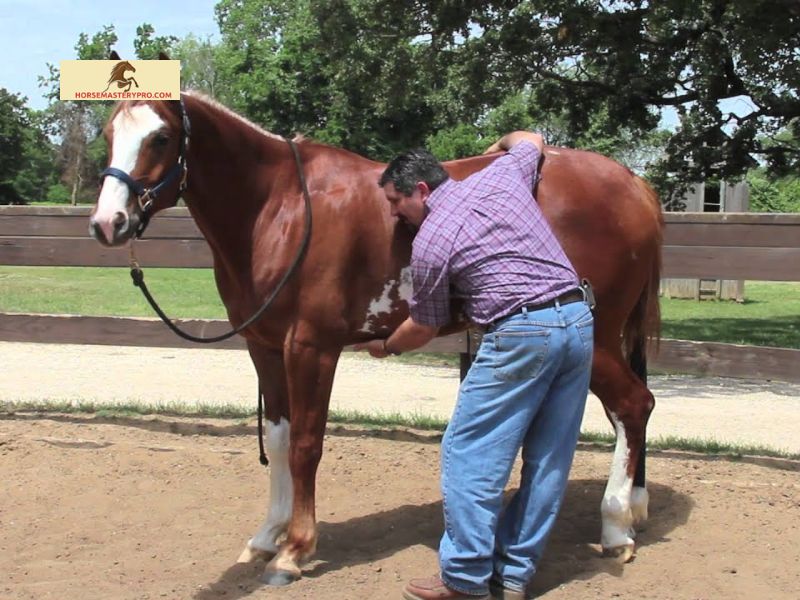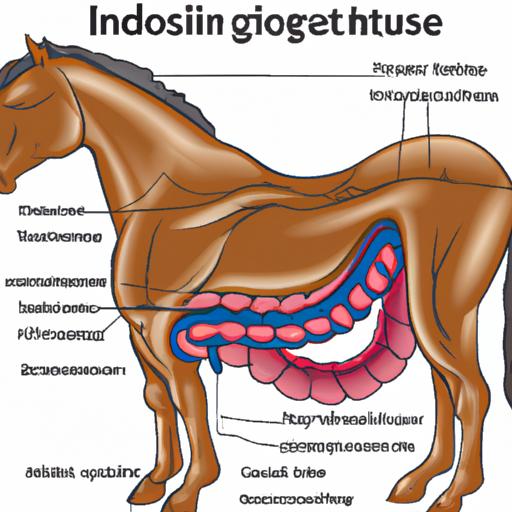Discover the subtle signs and effective treatment options for symptoms of hindgut ulcers in horses. Ensure your equine companion’s well-being and performance.
Symptoms of Hindgut Ulcers in Horses: As equestrians, we share an unspoken connection with our beloved horses. We can sense when something isn’t quite right, even if they can’t tell us directly. One common issue that often goes undetected is hindgut ulcers. These painful and debilitating conditions can significantly impact our equine companions’ well-being, making it crucial for us to recognize the signs and seek appropriate treatment promptly.
Introduction

Understanding Hindgut Ulcers in Horses
Picture this: just like humans, horses have a sensitive digestive system that can be prone to ulcers. Hindgut ulcers, specifically, occur in the large intestine and cecum of these magnificent creatures. These ulcers are commonly caused by factors such as stress, intense exercise, dietary imbalances, or prolonged use of nonsteroidal anti-inflammatory drugs (NSAIDs).
Importance of Identifying Symptoms
Now, you might be wondering, “Why is it so important to identify the symptoms of hindgut ulcers?” Well, my friend, the answer lies in our responsibility as horse owners and caretakers. If left untreated, hindgut ulcers can lead to significant discomfort, decreased performance, weight loss, and even behavioral changes in our equine friends. By recognizing the subtle signs early on, we can take proactive measures to provide the necessary care and ensure their well-being.
So, let’s embark on this journey together as we delve deeper into the world of hindgut ulcers in horses. By understanding the symptoms and seeking proper diagnosis, we can take the reins in ensuring our horses lead healthy and fulfilling lives.
Stay tuned for What are Hindgut Ulcers? where we’ll explore the definition, causes, and the intricate workings of our equine companions’ digestive system.
Remember, you can always count on horsemasterypro.com for expert guidance and valuable insights to nurture your equine partnership.
What are Hindgut Ulcers?
Definition and Causes
When it comes to hindgut ulcers in horses, it’s essential to understand their definition and the underlying causes. Hindgut ulcers refer to the formation of sores or erosions in the large intestine and cecum of our equine companions. These ulcers can vary in severity, ranging from mild inflammation to deep lesions that penetrate the intestinal lining.
But what triggers the development of these distressing ulcers? Well, several factors can contribute to their formation. One primary cause is stress, which can result from various sources such as rigorous training, transportation, or changes in the environment. Additionally, dietary imbalances, including high-starch or low-fiber diets, can also play a significant role in hindgut ulceration. Prolonged use of nonsteroidal anti-inflammatory drugs (NSAIDs), commonly administered to manage pain in horses, can further exacerbate the risk.
Understanding the Digestive System of Horses
To truly grasp the impact of hindgut ulcers, we need to delve into the intricacies of our equine companions’ digestive system. Unlike humans, horses rely on a continuous flow of forage to maintain optimal gut health. Their digestive tract is designed to process large volumes of fiber-rich food, promoting a healthy balance of acids and enzymes.
The hindgut, consisting of the cecum and large intestine, plays a crucial role in the horse’s digestive process. Fermentation of fibrous material occurs here, ensuring the breakdown of complex carbohydrates and the absorption of essential nutrients. Any disruption in this delicate ecosystem can lead to hindgut ulcers, hindering the overall digestive efficiency and causing discomfort for our equine friends.
As responsible horse owners, it’s vital to have a solid understanding of the digestive system and how it relates to hindgut ulcers. Armed with this knowledge, we can take proactive measures to support our horses’ gastrointestinal well-being.
In the upcoming Common Symptoms of Hindgut Ulcers in Horses, we’ll explore the subtle signs that indicate the presence of hindgut ulcers. Stay tuned for more valuable insights from horsemasterypro.com, your trusted resource for all things equestrian.
Common Symptoms of Hindgut Ulcers in Horses

When it comes to identifying hindgut ulcers in horses, it’s essential to be vigilant and observant. These silent afflictions can manifest in various ways, often presenting subtle signs that may easily go unnoticed. By familiarizing ourselves with the common symptoms, we can be proactive in recognizing and addressing any potential issues. Let’s explore the key indicators that may suggest hindgut ulcers in our equine companions.
Changes in Behavior
Our horses are creatures of habit, and any sudden alterations in their behavior can be a red flag. Look out for signs of irritability, sensitivity to touch, or an overall grumpy demeanor. If your once cheerful and cooperative partner becomes increasingly resistant or displays uncharacteristic mood swings, it could be an indication of hindgut ulcers.
Altered Eating Patterns
Horses with hindgut ulcers may experience changes in their appetite and eating habits. Keep a watchful eye for decreased feed intake, picking at hay, or even turning away from their usual meals. They may exhibit signs of discomfort while eating, such as pawing the ground, biting at their sides, or stretching their necks out excessively.
Weight Loss and Poor Condition
Unexplained weight loss or difficulty maintaining a healthy body condition can be a result of hindgut ulcers. Despite consuming an adequate diet, horses with ulcers may struggle to maintain their weight or even experience a rapid decline. Their coat may appear dull, and they might lose muscle tone, signaling an underlying issue that warrants investigation.
Decreased Performance and Reluctance to Work
If your equine partner suddenly exhibits a decline in performance or becomes uncharacteristically unwilling to work, it may be more than just a bad day. Hindgut ulcers can lead to discomfort, causing horses to resist or struggle during training sessions. Pay attention to any changes in their willingness to engage, as it could be an indication of an underlying hindgut issue.
Gastric Upsets and Diarrhea
Hindgut ulcers can disrupt the delicate balance of the digestive system, leading to gastric upsets and loose stools. Keep an eye out for signs of diarrhea, increased gas production, or frequent bouts of colic. These digestive disturbances are essential clues that can help us identify potential hindgut ulcerations.
Other Potential Indications
While the aforementioned symptoms are the most common indicators of hindgut ulcers, it’s essential to note that horses may exhibit other less specific signs. These can include poor coat quality, reduced overall performance, sensitivity to grooming, or a general lack of enthusiasm. Trust your instincts and consult with a veterinarian if you suspect something isn’t quite right.
By familiarizing ourselves with these symptoms, we can become better equipped to spot the subtle signs of hindgut ulcers in our equine companions. Stay tuned for “Diagnostic Methods for Hindgut Ulcers,” where we’ll explore the various approaches to diagnosing these conditions accurately.
Remember, horsemasterypro.com is here to guide you through every step of your journey as an equestrian enthusiast, ensuring the health and happiness of both you and your equine partner.
Diagnostic Methods for Hindgut Ulcers

When it comes to the well-being of our equine companions, accurate diagnosis is paramount. Identifying hindgut ulcers in horses requires a comprehensive approach that involves various diagnostic methods. Let’s explore these methods to gain a better understanding of how veterinarians determine the presence of hindgut ulcers.
A. Veterinary Examination and Medical History
The first step in diagnosing hindgut ulcers is a thorough veterinary examination. Veterinarians, with their expertise and keen observation skills, can assess your horse’s overall health and look for clues that may indicate hindgut ulcers. Additionally, providing a detailed medical history of your horse’s symptoms, diet, exercise routine, and any recent changes can significantly aid in the diagnosis.
B. Endoscopic Evaluation
To get a closer look at the internal gastrointestinal tract, veterinarians often employ endoscopic evaluation. This non-invasive procedure involves inserting a flexible endoscope through the horse’s anus, allowing visualization of the large intestine and cecum. By examining the lining of the hindgut for any signs of ulceration or inflammation, veterinarians can confirm the presence of hindgut ulcers.
C. Fecal Testing and Laboratory Analysis
Fecal testing and laboratory analysis are valuable diagnostic tools that help veterinarians gather further evidence of hindgut ulcers. By analyzing fecal samples, veterinarians can identify any abnormal levels of bacteria or parasites that may contribute to the development or exacerbation of ulcers. Laboratory analysis of blood samples can also provide insights into inflammatory markers or other indicators of hindgut ulceration.
Remember, accurate diagnosis is essential for effective treatment. By collaborating closely with your veterinarian and utilizing these diagnostic methods, you can pave the way for a tailored treatment plan that addresses your horse’s specific needs.
Stay tuned for Treatment Options for Hindgut Ulcers, where we’ll explore various approaches to manage and alleviate the symptoms of hindgut ulcers in horses.
At horsemasterypro.com, we’re committed to equipping you with the knowledge and resources to optimize your equine partnership.
Conclusion: Nurturing Your Horse’s Digestive Health
As we wrap up our exploration of hindgut ulcers in horses, it’s clear that recognizing and addressing the symptoms of this condition is paramount for the well-being of our equine companions. By understanding the causes, symptoms, diagnosis, and treatment options, we can empower ourselves to provide the best possible care for our horses.
Remember, at horsemasterypro.com, we are committed to sharing our expertise and helping you navigate the complexities of horse care. If you suspect your horse may be suffering from hindgut ulcers or any other health issue, consult with a qualified veterinarian for a thorough examination and tailored treatment plan.
To maintain your horse’s digestive health and prevent the onset of hindgut ulcers, prioritize proper nutrition and feeding practices. Implement dietary adjustments, such as increasing forage intake and minimizing high-starch feeds, to promote a healthy gut environment. Regular exercise and turnout are also essential in reducing stress and maintaining optimal digestion.
Stress management techniques, such as providing a calm and consistent environment, can significantly contribute to preventing hindgut ulcers. Additionally, regular veterinary check-ups and health maintenance, including fecal testing and endoscopic evaluations, are crucial to detect any underlying issues early on.
At horsemasterypro.com, we stand by you in your journey of nurturing your equine partner’s well-being. Together, let’s ensure our horses live their best lives, free from the discomfort of hindgut ulcers and thriving in their equestrian pursuits.
horsemasterypro.com – Your trusted resource for expert guidance on horse care and horsemanship.


